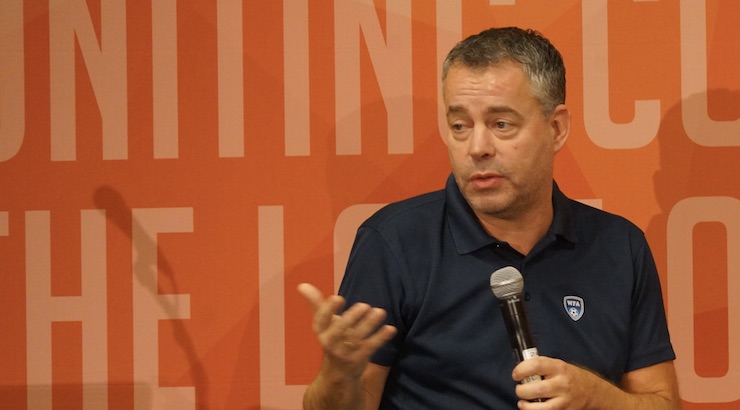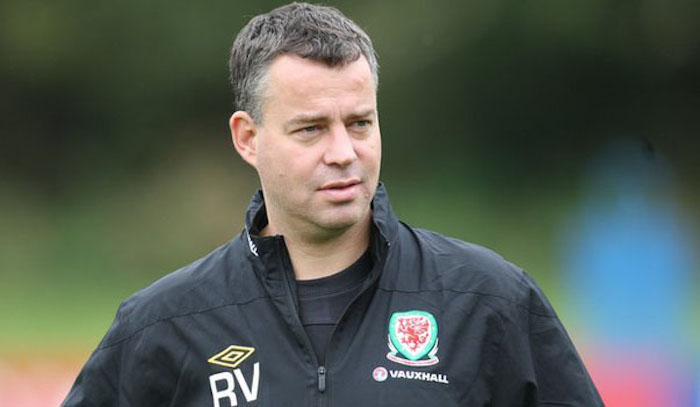World Football Academy USA’s Verheijen is A Refreshingly Honest Coach Educator
Headquartered in the Netherlands, with world-renowned coach Raymond Verheijen serving as CEO, the WFA services over 2,000 football specialists in more than 20 countries per year. January 2020, Verheijen is coming to do a special session in Baltimore.
Youth Soccer News: The World Football Academy USA (WFA) is Raymond Verheijen organization dedicated to educating coaching and improving the quality of player development.
Read: RAYMOND VERHEIJEN SHOCKS SOCCER COACHES AND OPENS THEIR MINDS
In an endless ocean of coaching education programs and speakers, Verheijen is unique. If you have ever attended a session, you know why. Outspoken, unafraid of shattering age-old norms and opinionated, Verheijen creates change through thought-provoking interaction.

SoccerToday Interview with Raymond Verheijen
Diane Scavuzzo: What are the biggest mistakes youth coaches in America make?
Raymond Verheijen: There are a few areas of concern.
First of all, many people in the US — in general and in US youth football in particular —are vulnerable to the ‘big names’ … Americans tend to think that famous and successful people in football know what they are doing and are also able to transfer their abilities to others.

This is an illusion. Many successful people are unconsciously competent.
They intuitively do the right things most of the time. This means they are really good at what they do but they do not know why.
Despite this lack of self-awareness, these successful people still try to educate others.
As a result, they often come up with elements which in reality are not the key factors of their success.
Scientific research has proven this problem time and time again.
Therefore, youth coaches should never copy the champion.

READ: WHY COPY OTHERS? RAYMOND VERHEIJEN WANTS SOCCER COACHES TO THINK
Another mistake youth coaches often make is applying something from another sport in the football context without reflecting on it’s relevance in advance. People often think that if something works in one sport it should automatically also work in another sport. However, this is often not the case.
You cannot simply ignore the context.

The final problem is the fact that youth football in the US is more a business model than talent development.
Governing bodies — but also coaches — often make decisions based on money rather tha based on what is best for the players.
Coaches are more worried about collecting certificates, building CV’s and winning trophies than anything else.
If I would run a club in the US, this is one of the first things I would change.
Children are no tools to build your career and to increase your salary.

Diane Scavuzzo: What is the best way to teach youth soccer players? To ask questions?
Raymond Verheijen: It has been scientifically proven that human beings learn most when experiencing something first before talking about that something.
This is also how our brain has evolved over a period of thousands of years.
In human evolution, competence came before comprehension.
So, coaches should allow players to play first before talking with them to develop comprehension.
And, when the coach does talk to his players, asking questions is indeed the best way.
But this questioning should take place within a clear reference. If children do not understand the context in which you ask them questions, you confuse them rather than making them understand as there is no direction during the questioning.

Diane Scavuzzo: I have quoted you as saying: “IF YOU ARE A SHIT COACH, OKAY BRING ON THE CONES” — Why do only unthinking coaches use drills with cones?
Raymond Verheijen: Why is this so stupid? If I remember correctly, I have made this comment in the context of fitness training.
In the US there is a big ‘fitness culture’. People think players have to be big, strong and fast. As a result, players often have to do all kind of non-football exercises in which they have to sprint around cones and jump over hurdles.
However, football fitness means fitness in the football context.
Consequently, football fitness training is training fitness in the football context. This is just a matter of logical reasoning.

Players who are running around cones and jumping over hurdles are training in a non-football context which means they develop non-football fitness.
The definition of football fitness is performing more football actions per minute to play with a higher tempo and to maintain the quality and quantity of these actions to play at a
If you want your players to play with a higher tempo it is your responsibility as a coach to develop a football exercise in which players are implicitly forced to perform more actions per minute than they are used to.
Every good football coach should be able to do this.
And if you are not good enough as a coach, the only alternative is to bring on the cones and to make your players non-contextually run around the pitch developing non-football fitness.

Diane Scavuzzo: What is the difference between CONSCIOUSLY INCOMPETENT and UNCONSCIOUSLY INCOMPETENT?
Raymond Verheijen: Incompetent means that a coach is lacking ability in a certain area. This coach is either aware of this room for improvement — consciously incompetent — or he is unaware of his inability —unconsciously incompetent.
In that case, the coach does not know what the coach does not know.
As a result, these coaches often keep doing what they are doing for the rest of their career. This is what we call denial.
On the other hand, coaches who are consciously incompetent are often looking for solutions and improvements as nobody wants to be incompetent in a certain area.

Therefore, the step from unconsciously incompetent to consciously incompetent is a crucial one in the development of any coach.
You can help coaches by first overloading them to expose the specific incompetence followed by showing them the mirror so they can become aware of their inability. This is exactly what I do during my courses.
I often create overload situations in the classroom to expose things and to allow coaches to develop self-awareness.
Updated November 14, 2019





